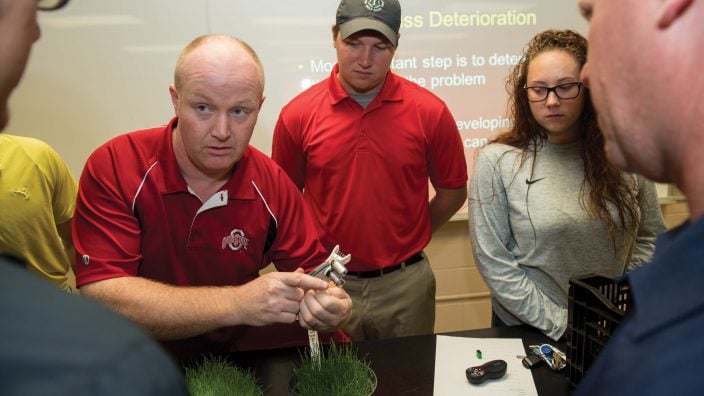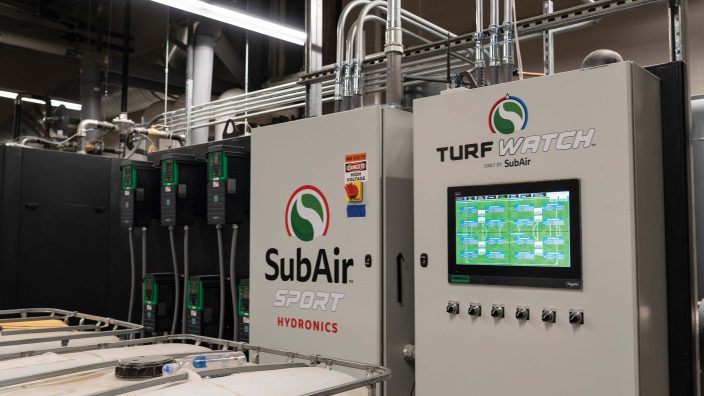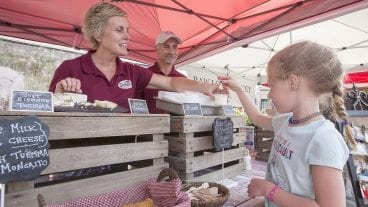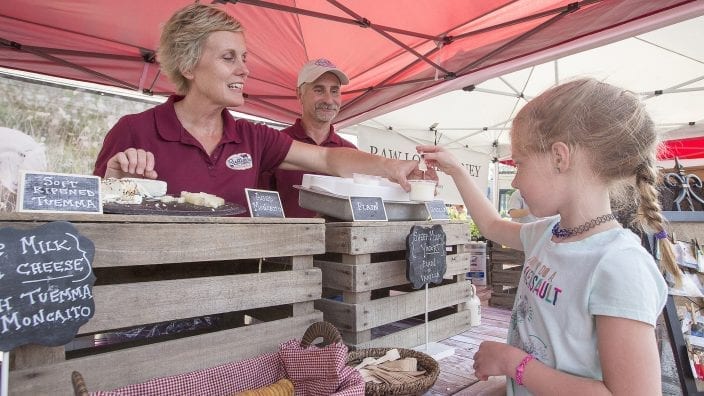Farmer’s Guide to Trucking Regulations available to Ohio Farm Bureau members
The guide includes a farm driver checklist, overview of state and federal regulations and exemptions, CDL qualifications and more.
Read More
When soccer players step onto the pitch for the first match at the New Crew Stadium on July 3, the turf will be trimmed to a precise seven-eighths of an inch and the surface will be irrigated just enough to reduce friction on the ball without leaving the surface sloppy.
But preparing the turf for Major League Soccer involves much more than careful mowing and watering. Ben Jackson, director of grounds for the Columbus Crew, oversees a highly controlled growing system for the turf in the new stadium.
Jackson first became interested in turf management when he was growing up in Columbus, watching the Crew play and playing soccer himself. He attended the first match when the Crew was started in 1996 and eventually convinced his parents he needed season tickets.
“I was a huge soccer fan. That’s the crux of why I do this,” he said. “ I was always impressed with how the field looked and played.”
Jackson wanted a nice playing surface for himself and his friends, so he started working on improving the turf in his own backyard. His dad then suggested he might follow his interests into a career in turf management. Right now, turfgrass management has become one of agriculture’s most promising fields with a variety of career paths available.
“The demand for graduates far, far outstrips the supply,” said Ed Nangle, interim program coordinator for the turfgrass science program at Ohio State University’s Wooster Campus. He’s seeing an employment rate of 100% for students completing the two-year associate degree program offered in Wooster.

Graduates are starting at salaries around $40,000 to $45,000 and moving upward to the $55,000 to $60,000 range within just a few years, he adds. Salaries continue to increase as managers gain experience and earn additional certifications.
The two-year degree program gives students plenty of hands-on, practical experience working at the campus golf course, sports fields and other green spaces. There they have a chance to “learn by screwing up,” Nangle said. The program also places students in internships where they can narrow down their career interests. Ohio State’s main campus in Columbus offers a four-year degree program in turfgrass management as well.
Jackson started his turfgrass journey through trial and error in his backyard, then he started working on the Crew’s turf as an 18-year-old high school intern. “I was as green as they come,” he recalled. He went on to study turf management at OSU, majoring in sustainable plant systems with a specialty in turf. He also completed additional internships in England and Colorado. In 2010, he returned to work full-time for the Crew as an assistant turf manager and graduated from OSU in 2013. Today, Jackson oversees management of the turf in the New Crew Stadium as well as the turf at the Historic Crew Stadium and training fields.
While many graduates go to work managing turf for golf courses or professional sports teams, there is also a growing demand for graduates to manage sports fields for high schools and city parks. Cities have started realizing there is an economic opportunity in providing well-maintained sports fields for hosting athletic events, Nangle explained. Managed turf improves the aesthetics of the fields as well as the safety for athletes.
Golf courses and professional sports organizations like the Columbus Crew regularly hire interns and participating in internships is a great way to get a start in the industry, Jackson said. “Hands-on experience sets you apart.”
Local sports turf management associations may be able to connect students with near-by internship opportunities. Ag colleges with turf management programs have industry connections to help students find internships as well. The demand is strong for motivated students, Jackson points out.
“Our industry is having a really hard time finding candidates to fill positions,” Jackson said. “I’m not sure current students are aware or understand how fun and rewarding a career in sports turf can be. As I’ve said from the beginning, it beats having a real job.”
The turf at New Crew Stadium is grown on a 10-inch layer of sand mixed with a small amount of peat. New fields start without much organic matter in the soil, so it can be a challenge supplying the grass with enough nutrients at first, because the nutrient holding capacity is low, Jackson said. “The nutrients run right through.” Over time, as the grass becomes established, more organic matter will build up in the root zone.
The sand used for the new soccer pitch is coarser and more angular than sand typically used for golf courses, Jackson said. The particles need to hold together to stand up to the traffic of a soccer match, which is more intense than traffic on a golf course. “They’re running full speed and trying to stop and turn,” he explained. “It is a significant amount of stress on those plants and roots.”
Below the sand is a 4-inch layer of pea gravel, and below that is a base of coarse gravel. The gravel layers help provide drainage, but the new pitch is also equipped with a piping system below the root zone that can rapidly pull water away from the playing surface. The same system can move heated air through the root zone to warm and aerate the turf, Jackson explains. The soccer season extends from February to December, so he needs to keep turf growing beyond Ohio’s ordinary growing season.
The 225-foot by 360-foot pitch is underlaid with 10.66 miles of red PEX tubing (the same type tubing commonly used in radiant floor heating systems). Sensors placed at three and six inches deep in the field collect data on soil temperatures as well as moisture levels. The system can increase the soil temperature as much as 28 degrees and it can maintain the soil temperature within a set range. “You can basically run it like a thermostat,” said Jackson.

In addition to the underground heating system, Jackson is using grow lights to provide supplemental lighting for the grass in spots that are otherwise covered by the stadium’s awning design. At the same time, he’ll be monitoring moisture levels and he can’t irrigate areas of the field where the lights are set up.
Even though it is an open-air stadium, the stands surrounding the pitch don’t allow much air movement at the playing surface. That’s one reason a high-performance sports turf variety of bluegrass was selected for the turf rather than ryegrass. Bluegrass tends to be more resistant to diseases that plague turf fields, is more heat tolerant, and puts out lateral roots, so the plants knit together, Jackson said.
Having time in between matches is critical to keeping the turf in top shape, Jackson says. “We need 10 days to two weeks to do any cultivation practices.” Overall, though, matches themselves aren’t as hard on turf as practice sessions, Jackson said. During practice players make more quick side-to-side movements, which can put a strain on the turf’s roots. For instance, if he sees cones set up for players to run around, he knows he’ll have some repairs to take care of. “My heart sinks a little bit,” he said.
Even though he can provide the turf at the new stadium with supplemental light, heat, water and drainage, Jackson still monitors the weather closely and adjusts management accordingly, just as farmers do.
“If you’re in ag, you follow the weather.”
Photos by Dave Gore


The guide includes a farm driver checklist, overview of state and federal regulations and exemptions, CDL qualifications and more.
Read More


Ohio Farm Bureau provides opportunities, platforms and resources to help you develop your voice in the industry and give farmers a seat at the table with leaders and legislators.
Read More

The emergency fuel waiver to allow the sale of summer gasoline blends containing 15% ethanol will lengthen the period during which Americans can continue buying E15 from June 1 to Sept. 15.
Read More

The Small-Scale Food Business Guide covers federal and state regulations for selling food products such as raw meat, dairy, eggs, baked goods, cottage foods, fruits and vegetables, honey and more.
Read More

New resources and technology are broadening the different types of sales tools and strategies available to farmers.
Read More

ODA will enroll 500,000 acres into the program for a two-week sign-up period, beginning April 22, 2024, through May 6, 2024. Contact local SWCD offices to apply.
Read More

Katie Share of Columbus has been named ExploreAg and Youth Development Specialist for Ohio Farm Bureau.
Read More

Mary Klopfenstein of Delphos has been named Young Ag Professional and Ag Literacy Program Specialist for Ohio Farm Bureau.
Read More

The plan has been updated to give sole proprietors access to more rate stability and a smart solution that offers potential savings on health care.
Read More

The American Farm Bureau Federation, in partnership with Farm Credit, is seeking entrepreneurs to apply online by June 15 for the 2025 Farm Bureau Ag Innovation Challenge.
Read More